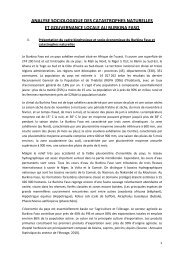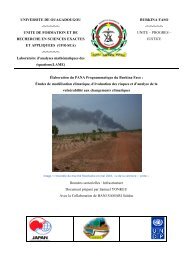UNDP Capacity Assessment Users Guide.pdf - Africa Adaptation ...
UNDP Capacity Assessment Users Guide.pdf - Africa Adaptation ...
UNDP Capacity Assessment Users Guide.pdf - Africa Adaptation ...
You also want an ePaper? Increase the reach of your titles
YUMPU automatically turns print PDFs into web optimized ePapers that Google loves.
<strong>UNDP</strong> <strong>Capacity</strong> <strong>Assessment</strong> Methodology User‘s <strong>Guide</strong>When determining the scale and scope of the assessment, it is decided which capacities need to beincluded in the assessment. What also needs to be decided is how these capacities will be assessed.This includes deciding on the kinds of input to collect and appropriate collection techniques.As discussed above, often the assessment team starts compiling materials before their first meeting withthe primary client to discuss the purpose and scope of the assessment.During the assessment, inputs can be collected either quantitatively or qualitatively. Since both have prosand cons, a capacity assessment should ideally generate both a quantitative ranking of capacity andqualitative information to support this ranking. Quantitative data, such as facts and figures, may forexample be seen as more ―legitimate‖ than qualitative information and may allow for an easiercomparison of the level of capacity across core issues and functional capacities. However, it can be usedfor comparison purposes that are not valid. Qualitative information, such as examples and anecdotes, canprovide context for the quantitative data collected, can be used to create a repository for ―institutionalmemory‖ and provides an opportunity to elaborate on and contextualize capacity gaps. A disadvantage ofusing qualitative input is that it does not allow for an easy comparison of capacity levels across issuesand functional capacities.If a quantitative approach is selected, a ranking scheme needs to be designed to determine the level ofdesired capacity and assess the level of existing capacity. The difference between the level of desiredand the level of existing capacity will determine the amount of effort required to bridge the gap betweenthem and will inform the formulation of appropriate capacity development responses.There are various ranking schemes that can be used to determine the level of desired capacity andassess the level of existing capacity (see Table 1 below). The easiest option is to use the same rankingscheme for all capacities to be assessed. The most complex option is to use a different ranking schemefor different capacities. Each option has its pros and cons. The assessment team will have to make atrade-off between ease of use and the depth and detail of the data & information collected. Irrespective ofthe choice, the same ranking scheme should be used to determine the level of desired capacity andassess the level of existing capacity.Table 1: Different quantitative ranking schemes for capacityOption # 1Option # 2Option # 3Same quantitative ranking scheme for allcapacitiesDifferent quantitative ranking scheme fordifferent types of capacityDifferent quantitative ranking scheme foreach questionPros: Easy and quick to applyCons: Not specific to any capacity type or categoryPros: More detailed insightsCons: No specific insights on capacities within anytype of capacityPros: Provides detailed insights on specific capacitieswithin each capacity typeCons: Time consuming to develop and executeOnce an option has been selected, it is up to the capacity assessment team to determine the scale of theranking and the value assigned to each ranking. For example, a team may decide to construct a rankingfrom 1 – 5, with one being the highest and five the lowest, or it can construct a ranking from 1 – 10, with1 being the highest and 10 the lowest. The wider the range, the more gradation the ranking will provide.However, too wide a range may make it difficult to compare findings.A possible ranking could be:1. No evidence of relevant capacity2. Anecdotal evidence of capacity3. Partially developed capacity4. Widespread, but not comprehensive, evidence of capacity5. Fully developed capacityA key design consideration is how the data & information collected data will be analyzed, reported andutilized. Collecting a wealth of input is pointless if there is not enough capacity to analyze and interpret13
















